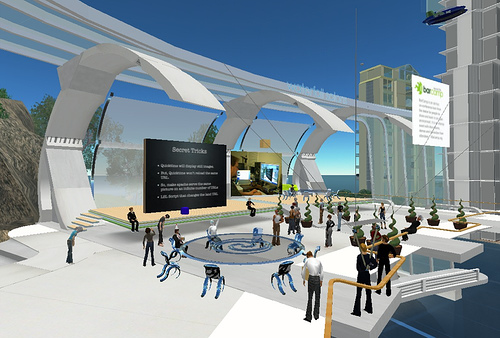For the tenth assignment, I chose to experience Second Life for the first time. Yee and Bailenson performed a study on the Proteus effect: the effect of transformed self-representation on behavior. Their main assertion is that our self representations are a significant and instantaneous impact on our behavior. Specifically, they claim that the appearances of our avatars shape how we interact with others. Keeping Yee and Bailenson’s studies in mind, I strategically constructed Hayleigh Hotshot to give me credible grounds for analyzing her appearance’s effect on my behavior on Second Life.
I purposely made Hayleigh Hotshot noticeably attractive with desirable attributes. At the same time, I tried to make her somewhat similar to me in real life so I could observe any differences with my behavior on Second Life and my behavior in real life. At first, when I was going through the tutorial, I was a bit frustrated because I didn’t understand what I had to do and I didn’t get a chance to interact with anyone. Soon enough I found that once I was off the initial island, there was never a dull moment in my Second Life experience.
Now it may be that I was more confident than I normally would have been in real life because, looking at my avatar, I felt ‘pretty’ and I guess the other people behind the avatars surrounding me caught on to that spunky confidence right away. Through one of their studies, Yee and Bailenson observed that participants who had more attractive avatars exhibited increased self-disclosure and were more willing to approach opposite-gendered strangers. My experience was consistent with this observation. In real life, I am usually shy when I interact with the opposite sex and it takes a long time before I am willing to open up to others. It was somewhat a surprise to me that when I went on Second Life as Hayleigh Hotshot, I immediately acted more attractively. From my experience in high school and college, I assumed that girls who were approachable and bubbly generally appealed to the opposite sex. Therefore, when others approached me in Second Life, I was very open and honest, disclosing personal interests that I never would have in real life.
Another factor that affected my behavior was the fact that I am 4’11 in real life, but I made my avatar 5’4. Oddly enough, those extra five inches did quite a bit to boost my confidence. Yee and Bailenson observed in another simulation that taller avatars were more confident in negotiation-oriented situations. In a way, I was more confident and took on the attitude of feeling like I was entitled to special treatment and a greater amount of respect from others just because I was taller. I definitely noticed that I got more attention from avatars of the opposite sex than female avatars that were shorter than me. I was also a lot more confident than the shorter female avatars.
In conclusion, Yee and Bailenson’s simulations surprisingly lined up with my experiences on Second Life. I was surprised because when I read the article I thought it was ridiculous to think that the appearance of an avatar could influence one’s interaction with others in an online environment. The Second Life and Yee and Bailenson’s studies opened my eyes and made me aware of the reality of online environments and the effects of self-representation on individual behavior, self-disclosure and inclination to interact with the opposite sex.
http://comm245blue.blogspot.com/2007/11/assignment-10-not-my-second-life.html
http://comm245blue.blogspot.com/2007/11/10-free-warcraft-for-ex-cons.html












